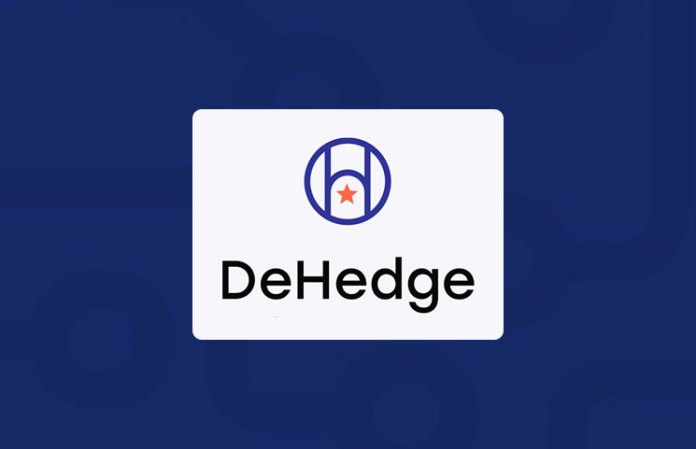DeHedge – DHT ICO Risk Hedging Crypto Trading For Investors?

DeHedge is a risk-hedging platform for cryptocurrency investors that promises to protect money invested in ICOs and cryptocurrencies. Find out how it does that today in our review.
What Is DeHedge?
DeHedge is a risk-hedging platform for cryptocurrency investors who want to protect their investments. The pre-sale for DeHedge tokens (DHT) begins in December.
DeHedge is a decentralized platform that insures investments in ICOs and cryptocurrencies, giving investors protection in case of exchange rate fluctuations, scams, project cancelations, or other unforeseen problems.
The platform is based around the use of smart contracts. You enter into a smart contract with DeHedge, and that smart contract pays out automatically in case of an insured event.
How Does DeHedge Work?
DeHedge is a decentralized insurance market. You enter into a smart contract with DeHedge. Each smart contract is programmed to automatically pay out in full if an insured event takes place. The entire platform is built on the Ethereum blockchain.
Investors can also waive an automatic payout and choose not to make an insurance claim. If the exchange rate drops below a certain amount, then the smart contract can pay you ETH or BTC in exchange for your tokens. Or, if you’re confident the price will come back up, then you can waive your claim and hold onto your tokens.
Another key feature of DeHedge is that its smart contracts use a binary relation algorithm based on insurance, reserves, and liabilities. This makes it impossible for insurance cover to exceed insurance reserves. In other words, DeHedge isn’t going to promise huge protection to insurers, then fail to pay out when an event takes place. This isn’t possible due to the logic of the smart contract. It’s impossible for liabilities to exceed the coverage.
The entire system revolves around DeHedge’s unique scoring model. That scoring model was developed “in collaboration with a world class consulting firm,” explains the official website.
Full details about the scoring model can be viewed in the DeHedge whitepaper. The system involves using proprietary software to process two types of information, including automatic collection and analysis of publicly-available data as well as manual data adjustments when necessary.
Some of the data analyzed by the DeHedge engine includes the project whitepaper, project web page, team information, social activity, Github and repository activity, blog articles, news and posts in popular online forums, token emission volume, token price during ICO, post-ICO token quotes, the number of investors, the amount of money being raised, the trading volume, and the number of bidders. DeHedge takes all of this information into consideration, then uses machine learning algorithms to assign projects to certain categories and domains.
The end result is that you can browse the DeHedge platform to view insurance prices for various ICOs. You might see one ICO listed on the platform with a 350 day insurance coverage package available. That package is priced at 14 DHT. Meanwhile, a shorter-term, 15 day insurance package for another ICO is priced at 2 DHT.
You buy one of these insurance packages, then receive protection in the event of a price drop. If the price of the token drops, then DeHedge will send a rate falling notice to your address. If the price drops below a certain point, then you can claim your insurance, in which case you send your tokens to DeHedge and they’ll pay BTC/ETH from their insurance reserve. If you’re confident the price will come back up, then you can also waive your insurance claim.
DeHedge Benefits
Overall, DeHedge aims to deliver benefits to ICO investors, cryptocurrency traders, institutional investors, and blockchain startups.
ICO investors are guaranteed the safety of their investments
Cryptocurrency traders can access protection against exchange rate volatility
Institutional investors can retain profitability and attract new investors by guaranteeing greater levels of protection than other funds
ICO projects can attract investors and protect against post-listing pump and dump schemes (investors will be more attracted to a project if it’s insured against a scheme like this)
ICO trading venues help to attract large investments in a project
Crypto exchanges insure transactions between clients
Crypto wallets can insure customer funds against hacks and protect their customers
Mining farm vendors can access protection against exchange rate volatility
As you can see, DeHedge aims to deliver major benefits to all members of the cryptocurrency community, from individual investors to the supply side. Companies can provide additional protection to their customers, while individual investors can purchase protection for themselves.
The DeHedge Token Sale
DeHedge is issuing a total of 10,000,000,000 (10 billion) DHT tokens. 80% of the total supply will be sold during the pre-sale/crowdsale. 15% is going to the project team and co-founders, 2% is going to the bounty program, and 1% is going to marketing.
The ICO begins with a pre-sale from December 4 to December 17, 2017. DeHedge is seeking to raise $3 million during the pre-sale. Investors get a 25% bonus, with a base rate of 1 DHT = $0.0165 USD (or the equivalent in BTC / ETH.
The general ICO, meanwhile, is scheduled for March 2018, closer to the release of the beta. More information about the general ICO will be released in January 2018.
Who’s Behind DeHedge?
DeHedge is led by founder and CEO Mikhail Chernov. Other key members of the team include Bogdan Leonov (Co-Founder and CCO), and Dmitry Ansimov (Co-Founder and COO).
DeHedge Conclusion
DeHedge provides a unique level of protection to the crypto industry. You can purchase insurance packages through the platform to enjoy protection against price drops, exchange rate fluctuations, and unexpected events. DeHedge’s system is based on smart contracts that pay out automatically when certain conditions are met.
To learn more about DeHedge, visit online today at DeHedge.com. DeHedge will launch the beta version of its platform in February or March 2018, with the full platform launching by late March.
https://steemit.com/@a-0-0